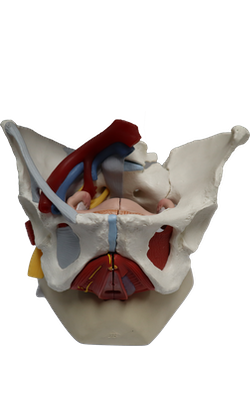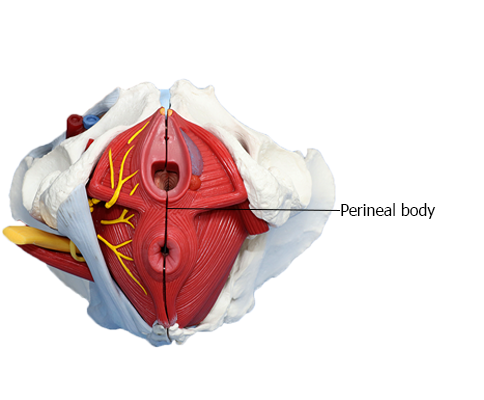Main Model

PERINEAL BODY

Perineum
The perineum refers to a shallow compartment of the body (perineal compartment) bounded by the pelvic outlet and separated from the pelvic cavity by the fascia covering the inferior aspect of the pelvic diaphragm, formed by the levator ani and coccygeus muscles. In the anatomical position, the surface of the perineum - the perineal region - is the narrow region between the proximal parts of the thighs; however, when the lower limbs are abducted, it is a diamond-shaped area extending from the mons pubis anteriorly in females, the medial surfaces (insides) of the thighs laterally, and the gluteal folds and superior end of the intergluteal (natal) cleft posteriorly.
The osseofibrous structures marking the boundaries of the perineum (perineal compartment) are the:
• Pubic symphysis, anteriorly.
• Ischiopubic rami (combined inferior pubic rami and ischial rami), anterolaterally.
• Ischial tuberosities, laterally.
• Sacrotuberous ligaments, posterolaterally.
• Inferiormost sacrum and coccyx, posteriorly.
A transverse line joining the anterior ends of the ischial tuberosities divides the diamond-shaped perineum into two triangles, the oblique planes of which intersect at the transverse line. The anal triangle lies posterior to this line. The anal canal and its orifice, the anus, constitute the major deep and superficial features of the triangle, lying centrally surrounded by ischioanal fat. The urogenital (UG) triangle is anterior to this line. In contrast to the open anal triangle, the UG triangle is "closed" by a thin sheet of tough, deep fascia, the perineal membrane, which stretches between the two sides of the pubic arch, covering the anterior part of the pelvic outlet. The perineal membrane thus fills the anterior gap in the pelvic diaphragm (the urogenital hiatus), but is perforated by the urethra in both sexes and by the vagina of the female. The membrane and the ischiopubic rami to which it attaches provide a foundation for the erectile bodies of the external genitalia - the penis and scrotum of males, and the pudendum or vulva of females - which are the superficial features of the triangle.
The midpoint of the line joining the ischial tuberosities is the central point of the perineum. This is the location of the perineal body, which is an irregular mass, variable in size and consistency, and containing collagenous and elastic fibers, and both skeletal and smooth muscle. The perineal body lies deep to the skin, with relatively little over lying subcutaneous tissue, posterior to the vestibule of the vagina or bulb of the penis and anterior to the anus and anal canal. The perineal body is the site of convergence and interlacing of fibers of several muscles, including the:
• Bulbospongiosus.
• External anal sphincter.
• Superficial and deep transverse perineal muscles.
• Smooth and voluntary slips of muscle from the external urethral sphincter, levator ani, and muscular coats of the rectum.
Anteriorly, the perineal body blends with the posterior border of the perineal membrane and superiorly with the rectovesical or rectovaginal septum.